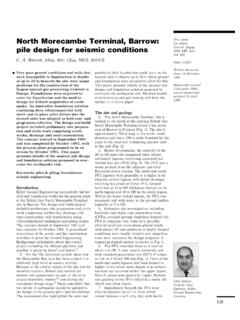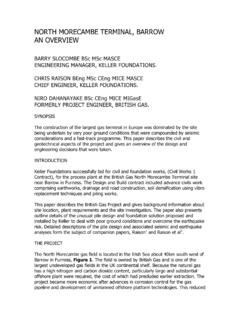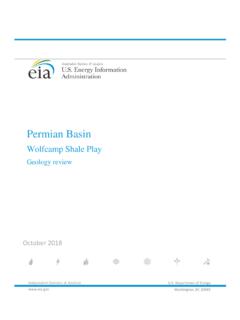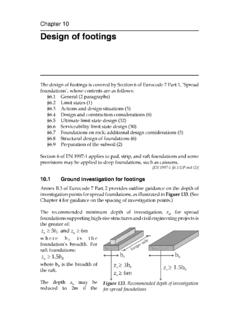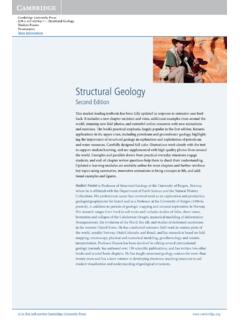Transcription of Design of piles – United Kingdom practice
1 ISSMGE - ETC 3 International Symposium on Design of piles in Europe. Leuven, Belgium, 28 & 29 April2016 Chris Raison & Derek Egan Design of piles United Kingdom practice1/ 24 Design of piles United KingdompracticeChris RaisonRaison Foster Associates, EganRemedy Geotechnics, paper gives an overview of the current UK practice for the Design of piles . In most instances, Design has adapted to conform to Eurocode 7. The obvious changes are the adoption of a limit state Design based on the application of partial factors. Limit state Design has been the normal approach for many years within the structural engineering field.
2 However, this has been a very difficult step for practicing geotechnical engineers used to a traditional working or allowable stress Design . Despite this, the basic Design methods in daily use have not changed. Neither has the approach to parameter selection which was always based on adopting moderately conservative ground properties. Perhaps the biggest change that has been facedbyUK geotechnical engineers is the focus on serviceability or SLS behavior rather than ultimate capacity as the controlling factor for many limit Solid GeologyThe geology of the UK and the distribution of soil and rock types is complex.
3 The solid geology as mapped by the British Geological Surveyis shown in Figure 1. The UK can be broadly divided into two areas; the south and east comprising younger sedimentarydeposits formed during the Jurassic, Cretaceous and Palaeogene periods. Many of these deposits have a relatively low strength and can be classified as soils [for example London Clay and Oxford Clay], but also include extensive deposits of Chalk. To the west of this area are Triassic rocks including Lias Clay, Mercia Mudstone [Keuper Marl], Sherwood Sandstone [Bunter Sandstone] running in a broad diagonal sweep across the UK, with Permian and Carboniferous rocks.
4 Much of the north and west of the UK comprises older rocks of the Palaeozoic 1: UK Solid GeologyISSMGE - ETC 3 International Symposium on Design of piles in Europe. Leuven, Belgium, 28 & 29 April2016 Chris Raison & Derek Egan Design of piles United Kingdom practice2/ and Superficial DepositsMost of the UK has been either directly or indirectly affected by glaciation which has resulted in extensive superficial deposits of glacial till, laminated clays and other glacial materials overlying the solid geology [Figure 2]. There are also major superficial deposits of estuarine soils in areas around some of the major river valleys, and around the coastal 2: Glaciation in the UKFigure3: UK Mining ActivityAfter ICE manual of geotechnical engineering (2012) PropertiesBecause of the complex geology and wide range of geological materials, the piling industry in the UK has had to cope with a range of materials, strengths andstiffness properties of the ground.
5 This has resulted in a diverse range of piling techniques and types of Design methodology have been developed for the lower strength cohesive and granular soils, but also the weak mudstones and sandstones and in particular the weak Chalk ActivitiesMuch of the UK has been subject to mining works that can have a significant impact on pile foundations. These include historic shallow and deep mining within the coalfield areas [see Figure 3], butalso extensive mining for minerals, iron ore, limestone and - ETC 3 International Symposium on Design of piles in Europe.
6 Leuven, Belgium, 28 & 29 April 2016 Chris Raison & Derek Egan Design of piles United Kingdom practice 3/ 24 2. SOIL INVESTIGATION Methodology and techniques for site investigation and the associated laboratory testing have developed over many years to suite the diverse geology encountered across the UK and the extreme range of soil and rock strength and stiffness. The most common form of site investigation is based on small diameter boreholes formed using percussive cable tool techniques through soils, with rotary coring used for recovering core samples from the harder materials and bedrock.
7 Both disturbed and undisturbed samples of soil can be recovered from the boreholes for laboratory testing. There is also extensive use of insitu testing carried out in the borehole or drillhole using the Standard Penetration test [SPT] equipment. Although a crude test, the simplicity of the equipment and relative low cost means that many test values can be obtained from a particular borehole. Laboratory testing of samples recovered from boreholes include a range of strength and stiffness testing depending on the quality of the recovered sample.
8 In the UK, most cohesive soils are subject to quick undrained triaxial [QUT] testing to establish an undrained shear strength for the soils and oedometer consolidation tests to assess stiffness properties. Effective stress triaxial and shear box testing is also carried out to determine fundamental strength parameters for a range of soils and weaker rocks. Much more common now is the use of insitu cone penetration testing [CPT], often with pore pressure measurements. CPT profiling provides both a very accurate assessment of the soil strata, but allows strength and stiffness parameters to be obtained based on empirical relationships.
9 Pressuremeter and dilatometer testing is also becoming more common for the larger projects. 3. PILING TECHNOLOGY & CLASSIFICATION The pile types used in the UK are diverse and mirror the wide range of geological materials present across the country influenced by the demands of development driven by regional population and/or industry centres. Broad trends in UK piling are presented below, however the piling market is highly dynamic in the UK and exceptions to the trends noted below abound. A good summary and description of available pile types in the UK is given by the ICE manual of geotechnical engineering (2012).
10 Displacement Piling Driven precast concrete piles are the predominant (and usually the cheapest) form of displacement piling and are very widely used for low to medium load applications. Typically designed as friction piles when founded in clay soils but also often designed as end bearing into coarse soils or onto rock. Driven cast in-situ piles can be particularly effective where founding into dense coarse soils. Some contractors also promote rotary displacement piling. Examples of driven steel tubular piles and H piles can be found but are not common.

